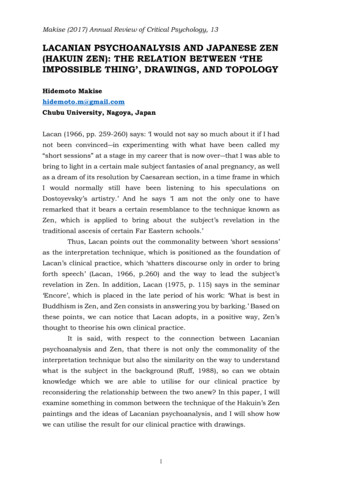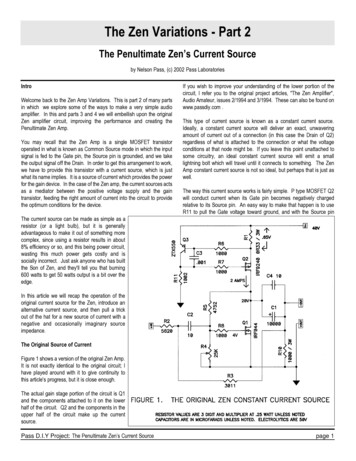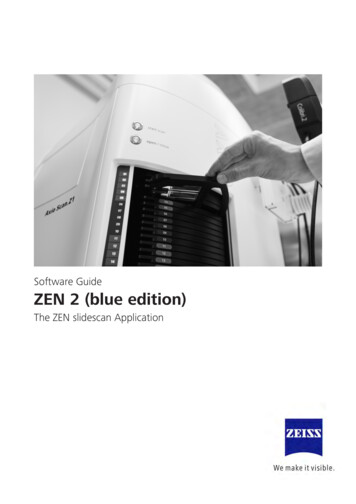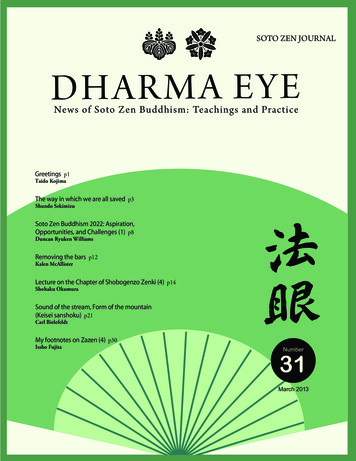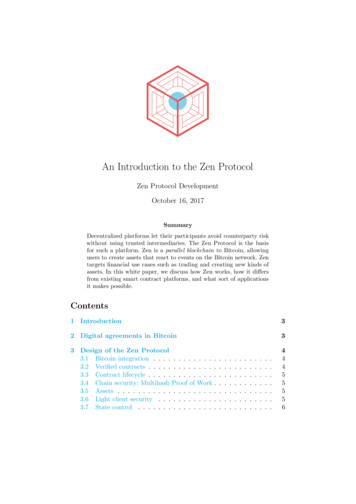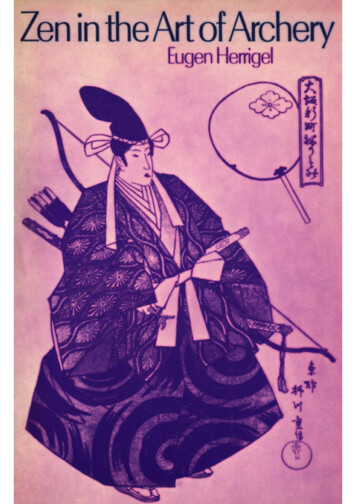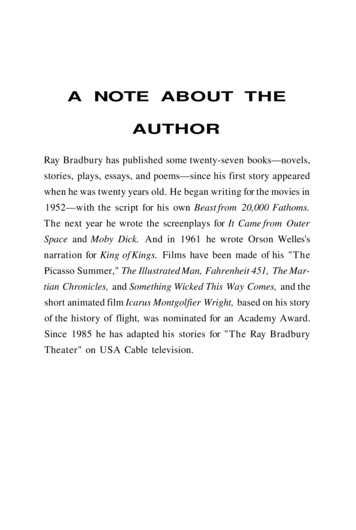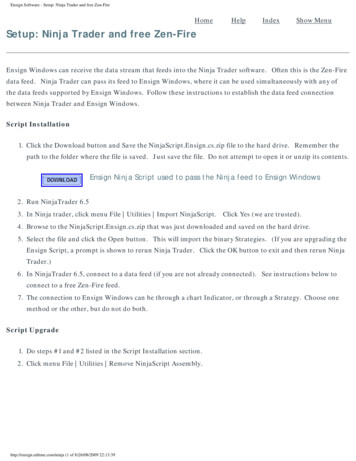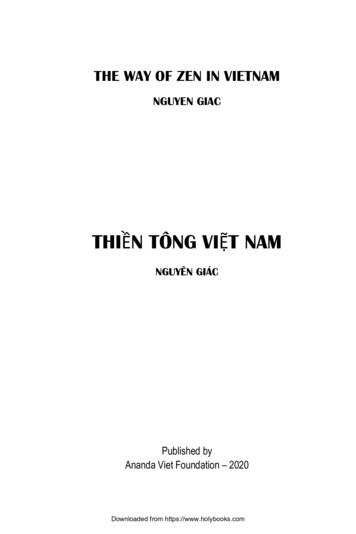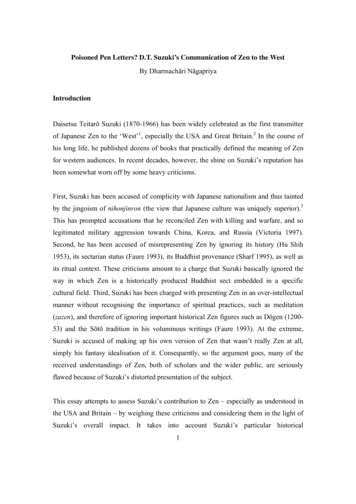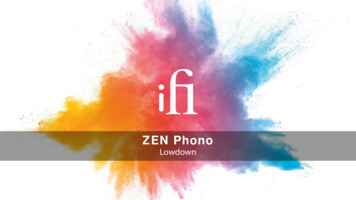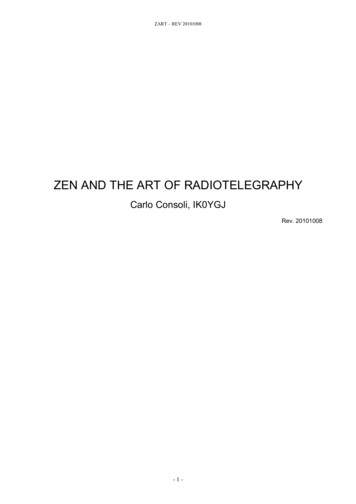
Transcription
ZART – REV 20101008ZEN AND THE ART OF RADIOTELEGRAPHYCarlo Consoli, IK0YGJRev. 20101008-1-
ZART – REV 20101008TABLE OF CONTENTSIntroduction.4Learning CW.6The four stages of learning.6The learning roadmap .8The physiology behind learning.10Learning and self-image.12First relaxation exercise .14Getting started with Morse code .15First Week .16Groups of the Week .21Second Week.22Groups of the Week .23Third Week .25Groups of the Week .28Fourth Week.30Groups of the Week .30Fifth Week.32Groups of the Week .33Sixth Week.34Groups of the Week .35Increasing speed: let’s go on-air .37Second relaxation exercise.40Adjusting spacing to speed .40A QSO in CW .42The DX Code of Conduct .46Increasing speed .46High Speed CW, going QRQ.51Feel the Force Luke! .53“Speed. I am Speed” .54Training to visualize.55Learning new words.56Practice, practice, practice .57Changing the telegraph key.57Discover your limits, and go beyond .58The rest, coming by itself.59Keys and Keyers .61The Straight Key .61The Paddle.64The Electronic Keyer .69The Bug.72The Sideswiper.76Building a CW career.79Naval Clubs.80High Speed Clubs.81FOC.83Amateur telegraphy from a linguistic perspective .85The lexicon.86The syntax .87A linguistic analysis of amateur telegraphy.89-2-
ZART – REV 20101008CW: the Esperanto of the Third Millennium ? .93Keying techniques compared .96Morse code and letter distribution .97Keys and keying techniques.99A quantitative comparison .100Single vs twin lever keys: evaluating the myth.102About the author.104Acknowledgments and Dedications.105Bibliographic References .106Copyright Notices .107Revision History .108-3-
ZART – REV 20101008IntroductionThis book is the result of several years of experience in amateurradiotelegraphy. It suggests, for the first time, a learning methodology based on anintegrated and multidisciplinary approach designed to accompany the apprentice fromthe first steps in ham radio all the way to a world-class proficiency in telegraphy. Thebook introduces, ad-hoc tailored to amateur radio, techniques used successfully bycompetitive athletes, including extreme sports such as free diving, adapted to thedifficult process of learning telegraphy.This book is not only written for the benefit of amateur radio operators whowant to learn this beautiful art, but it also meets the urgent need felt by the author tonarrate his own path of development that has radically transformed him and the manyfriends with whom he shared the pleasure of such a long learning process and theimmense joy of the discovery, both from the technical and from the human point ofview.Wireless telegraphy is the discipline of sending and receiving signals in Morsecode and, although it started “only” as a technical tool, it soon proved to be an art.Definitely a special kind of art: like a butterfly, it had a shiny but short life, rising andfalling throughout the 20th century. The first implementation of Morse code wascreated in 1832, employing a numeric code for the most common English words, andthe numbers translated into a sequence that used just two symbols: dash and dot.Morse code, as we know it today, i.e., encoding letters and numbers in a seriesof dots and dashes, is actually an invention of Alfred Vail, an assistant to SamuelMorse in 1844. It is a historical reality that Morse, in fact, stole the idea from Vail.Morse code was created initially as a combination of dots, dashes, long dashes, shortand long spaces. We had to wait for wireless telegraphy, and therefore the twentiethcentury, to find the definition of the standard Morse code or “International Morse”,made of dots and dashes, spaced according to standard criteria.It was only thanks to the genius of Guglielmo Marconi that telegraphy "tookoff", by leaving the ground (i.e. transmission cables) in the true sense of the term, andgetting “on the air”. On December 12th, 1901 Marconi sent the first Morse signalsacross the Atlantic, and a new invention, whose gigantic power was still to be fullyunderstood, arose: wireless telegraphy. Since then, many lives were saved, as in thefamous case of the Titanic (1912), and the wireless telegraph has evolved andexcelled as no one could have imagined.-4-
ZART – REV 20101008After a century of successes, in 1998, coastal maritime radiotelegraphyinstallations have been replaced by satellite communications, which eventuallyprovided a much more secure and reliable connection. As a result, telegraphy isslowly sliding into oblivion. As a direct and inevitable consequence, in 2005telegraphy also disappeared from amateur radio exams. Surprisingly, this condition ofuselessness elevated radiotelegraphy to the rank of an art.Despite this aging process, telegraphy is still very much alive with radioamateurs, because it offers the possibility of communicating over great distancesusing inexpensive transmitting and receiving devices. Such devices are even simplerto build. A contact based on telegraphy is made in a universal language that, likeEsperanto, pulls down any social, geographical and cultural barrier. The amateurradio operator uses a code that not only shortens the speech, but also allows him tocommunicate with people living in any part of the world, near or distant, regardlesstheir language or culture. Thus, wireless operators can greet each other using acommon language even if one is Chinese and the other Guatemalan.The question is: what is so special about radiotelegraphy, in the era of theInternet and global mass communication, compelling us to accept a long and arduouspath of learning, requiring mental and practical training, trying harder and harder tolearn such a language?Anyone starting the exciting and hard journey into radiotelegraphy is attractedby the fact of pursuing an art requiring style and precision, two characteristics thatmay be obtained only through study and practice. It is also matter of aesthetics: acontact in telegraphy made with precision and respect for procedures is a work of art,unique and unrepeatable in time. The wireless telegraphy radio operator, today, is aperson who not only learns to "play" a very special instrument, but also learns a newlanguage, made of a single tone, cadenced by rhythmic intervals. Learningradiotelegraphy is a journey within our own emotions and feelings that requires atransformation of the way we learn and how we feel. Much like a child, who mustlearn to speak, revealing a new mode of expression and communication with theoutside world. It is a steep and thorough experience requiring continuous contact withthe deeper layers of our being.So strong is the passion for radiotelegraphy that, in Italy, Elettra Marconi,president of Marconi Club ARI Loano and daughter of Guglielmo Marconi, todayreleases the honorific title of wireless radio operator to whom excels in the practice ofthis art. Oscar Wilde used to say that art is useless: as such radiotelegraphy is, too.Having fallen into disuse for practical applications, it lives its moment of glory as anart in the hands of the few people who, in a "swinging mood" made of sweetintermittent sounds, are keeping it alive.This book is distributed under the Creative Commons license and can be freelycopied or distributed, under certain conditions (see the Copyright Notices chapter fordetails). This work is “QSLWare”: if you like it, just send me a QSL card via thebureau.-5-
ZART – REV 20101008Learning CWThe issue of radiotelegraphy obsolescence (CW mode emission, or ContinuousWave) is being passionately discussed in the amateur radio world: today CW isdefinitely decommissioned, in Italy and in several parts of the world, in allprofessional activities: military, maritime, postal, railways.Since 1998, all CW maritime radio transmissions were replaced by satellitesystems, which can provide greater reliability and security of the link. Telegraphywas also removed from amateur radio exams, resulting in increased overcrowding inthose parts of the HF bands allocated to the voice modes of amateur radio, sincepassing the exam was much easier than before. So, many amateurs turned back toconsider CW, in part attracted by the opportunity to enjoy portions of bandwidthexclusively reserved for CW, but mainly because of the attraction to exercise an artthat requires precision and style and has to be developed constantly, with study andpractice.Is, then, the art of radiotelegraphy, undisputed protagonist of the twentiethcentury, destined to disappear into thin air? We would say that it might not be thecase: by quoting Urbano Cavina, I4YTE ("Marconisti d’Alto Mare" Ed C & C): CWis left with enough health to be hailed as the Latin of the new era, and even more, theEsperanto of the new millennium.Once learnt, CW can never be forgotten: all the hard work is rewarded by aprecious art that will accompany the ham for life. As the English say, "there is no freelunch": learning CW is a lengthy process that must be tackled in stages, trainingevery day for a period consistent with the stage of learning. CW is an art and like allarts it cannot be learnt only by studying: however hard you try or how much time youspend, you need to achieve the mental condition to be a wireless radio operator, not todo wireless telegraphy. And, there is a big difference.The four stages of learningTalent matters, of course. Aside from that, what really is important here is yourability to get in touch with the deepest levels of your mind to acquire, day after day,the mental structures of being a wireless operator. It is quite a long journey in whichthe prize is the journey itself.-6-
ZART – REV 20101008According to Zen Buddhism, learning is a journey through awareness andknowledge in four stages:ooooUnawareness of lack of knowledgeConscious lack of knowledgeConscious knowledgeUnawareness of knowledgeThe initial stage is about unconscious lack of knowledge: where we simply donot know what we want to learn. The student approaches the subject he wants tolearn, hopefully with an open mind. He has not even the slightest idea of what standsbefore him and the challenges he could be facing. The student does not even knowwhat he doesn’t know! Of central importance at this stage is the leadership role of theteacher, who welcomes and guides, step by step, the student on his way fromignorance to knowledge. The phase of unawareness of lack of knowledge lasts for arelatively short time. A careful student is able to immediately understand what heneeds to do, especially if the path is steep. In learning CW, the stage of unconsciouslack of knowledge begins when you decide to learn telegraphy and listen for the firsttime to the intermittent sounds of dots and dashes. You immediately understand thatthere must be a pattern, a meaning, a structure behind these harmonious sounds butyou cannot perceive it.Start your journey open-mindedly towards this new art, cast aside the manyquestions and doubts, and keep up your willingness to learn. Rest assured: you willbe able to answer and cope with all of your doubts and uncertainties.The second stage is the conscious lack of knowledge: the disciple began hisstudies in continuous contact with the teacher, learning step by step all the basics buthe practices with uncertainty. He knows what he has learnt and has to improve hispractice. He also knows what else is yet to be learnt. The student knows that he is notknowledgeable. Later, he will discover that he had always known, but he was notcertain he actually did! This stage usually lasts just long enough to learn all the basicelements of the object of his study. In CW, this phase is focused on learning thesounds of letters, numbers and symbols of Morse code. Remain open-minded andsimply skip over everything you might not understand. Be confident of the fact thatyou will be able to retain everything you are able to decode for the first time. Thismeans that when you understand a sound, the relationship between the sound of eachletter, and the word it is part of will remain yours forever.The third stage is the conscious knowledge: the student has learnt and he isaware of what he has learnt. Each time he uses the knowledge gained, he is fullyaware of it and acts wisely to achieve the goals he planned for himself, leveraging onthe gained knowledge. The student knows and knows he knows. This phase is thelongest and, in certain arts, it could last for decades. But do not worry because it is-7-
ZART – REV 20101008also the phase bringing to you the greatest satisfaction: remember that the prize is thejourney itself, not the final goal. In learning CW, at this stage you will be perfectlyable to understand Morse code but you will need paper and pencil to jot down whatyou receive. You will be limited in terms of speed of reception and transmission andsome words will seem incomprehensible. At this stage it is of fundamentalimportance to practice on a daily basis. On some days you will go like a lightning,and on others it will seem to you like you forgot everything. Stay cool, stay focusedand open-minded. Ignore any error, it will resolve itself.The fourth phase is about unconscious knowledge: the student has learnt aboutall there is to learn (from others) and obtains additional knowledge from the practiceof the art itself. At this stage, he is no longer even conscious of exercisingknowledge. The student knows and uses what he knows spontaneously. In CW, this isthe stage where you will be able to receive and transmit at speeds limited only byyour physical capabilities and by the mechanical features of your telegraph key, youwill be able to listen and understand signals amid utterly deafening noise or whileyou're busy doing other tasks, without writing or making any conscious effort. Thiswill hold true both in transmitting and in receiving.The learning roadmapWe will approach learning in the four stages, in a form specifically designedfor learning CW, in three distinct phases:1. Learning the elements of the Morse code alphabet and their spacing.2. Speed consolidation up to a maximum of 20 words / 100 characters perminute, using paper and pencil to copy down what you receive.3. Increase speed and decode "in your head."In the first phase, for six weeks, we study each Morse code alphabet element,learning it as a sound. A group of characters per week. Keep practicing every day, notexceeding the time assigned for your training sessions. Practice often, for a shorttime. At this stage, we focus exclusively on the receiving. To start learning CW wewill use software (therefore you must be equipped with a personal computer) andenable it to introduce letters and numbers gradually. We will learn the letters bygroups: ETANIM / DSOURC / KPBGWL / QHFY / ZVXJ / 12345 / 67890. Lettersare grouped together in increasing length. Our training will be focused on receivingletters and numbers, copying down on paper. Sessions will last no more than 10-15minutes a day. Speed will be starting from a minimum of no less than 10 (preferably15) WPM. When you are able to copy on paper all the letters of a group, you moveon to the next one.-8-
ZART – REV 20101008In the second phase, lasting about 5-7 weeks, we introduce punctuation marksand procedural signals. We also consolidate reception and transmission speed up to100 characters (or 20 words) per minute, always using pen and paper. At this stagewe begin to use a straight key. Do the best you can to transmit with a timing andspacing as close as possible to the one you just heard from the computer. As we cancopy on paper 90% of the characters sent by the PC, we increase the speed by 1-2WPM or 5-10 characters per minute. Our goal is to reach a speed of 20 WPM.The purpose of the third phase, of variable duration, is to achieve the delicatetransition of abandoning pen and paper and decoding entirely in your head. Here youwill learn new words and improve your reception speed gradually but inexorably.Remember: accuracy transcends speed – it is better to go slower and be understood.Exercise the art of CW with style. Obviously, achieving a remarkable accuracy intransmission requires practice and if you do not try, you will never succeed. Finding aham radio friend, patient enough for long CW contacts, is an absolute must. Go,freewheel at speeds above 20 WPM. Always keep yourself within your own limits,try to correct your errors, but don’t feel blocked or overwhelmed by them. Simply,keep going!Learning CW for a naval radio operator requires (well, actually required)instruction by a qualified radio operator. The main difference between an amateurradio operator and a marine officer is that the latter is instructed to transmit andreceive at an impeccable commercial speed of 25 WPM, for long shifts and underadverse environmental conditions. Such a capability requires a radically differentapproach to learning.The amateur, conversely, learns CW to use it, generally speaking, for arelatively short time, in a stress-free and optimal environment. In these shelteredconditions, the amateur can operate at a speed twice as fast as the commercialoperator. Such a way of using CW requires a specific method of learning. Themethod proposed in this book is aimed at ham radio operators by providing them allthe relevant information for building a "career" as a CW expert. We will discuss the"career" of a CW amateur radio operator in a dedicated chapter in this book. Thismethod stems from hands-on experience by the author, who has learnt by trial anderror, mistakes and corrections, to develop a method proven effective for teaching.Our goal may seem overwhelming, but if we break it down in small parts, thewhole path will be developing by itself. In the course of the book you will be givenspecific targets, each representing only a small step and requiring solely a certainconstancy of practice and study. Always stay focused to your next target and, soonerthan you might think, the end of your journey will be in sight.Especially during the first stage, in preparation for high-speed CW (or, inamateur radio shorthand, QRQ), we must keep practicing each and every day. Weneed to settle, literally “embed”, the sounds corresponding to different letters intoourselves. QRQ will be great fun, we will face it in the third stage of learning. This-9-
ZART – REV 20101008stage could be also conducted using other methods, such as various software-basedKoch methods or the Learn CW Online web site (http://lcwo.net/) by FabianDJ1YFK. What really matters, here, is to the learn characters as sounds, not as acomposition of distinct graphic elements.The method proposed in the first phase of learning, in this book, is specificallyaimed to achieve the fastest possible transition to the next stage and, thus, gain a solidfoundation for the QRQ phase. It is important to say, again, that the student mustfocus on learning sounds. This is the reason why a radiotelegraph key is not adopteduntil the end of the first phase.The physiology behind learningTo learn CW means approaching the learning process in a completely newfashion. Well, actually new only for an adult, because we already underwent thislearning experience in our childhood. CW is not learnt with the "mad and desperatestudy" like Leopardi, the Italian poet, did. We do not need to learn things by heartbut, rather, by applying a constant and assiduous sedimentation of few, simpleelements.Our brain, in its intricate complexity, is made of several “departments”, eachdevoted to specific functions. Among them, the brain cortex is responsible for"conscious" thought, for calculus, evaluation and measurement. The cerebral cortex,the so-called "gray matter", attends to memory, attention, thought, consciousness andlanguage processes. It allows us to perform complex calculations: it is a verypowerful part of the human brain. Unfortunately, the gray matter is as powerful as itis slow. While learning a new language, we must engage the cerebral cortex at thebeginning of our learning process: new “brain departments” will be created, built, tostore and attend to the language just learned. CW also, from the perspective of thebrain, is a language itself: we must learn to "listen" (receive) and "talk" (transmit) intelegraphy as it is for all other “ordinary” languages. For all such activities, thecerebral cortex is essential.William Pierpont N0HFF, author of the ground-breaking book “The Art &Skill of Radiotelegraphy”, in the introduction, tells us about the gigantic difficultieshe faced in overcoming a certain threshold in speed of reception. Like many otherhams, he learned, at first, the Morse alphabet in a purely cortical fashion: he studiedthe graphic signs, made of dots and dashes, instead of sounds. Douglas tells of theenormous effort he had to go through to get rid of this handicap and re-learn theletters as sounds using completely different areas of the brain.As we make progress in learning telegraphy, we find that the cerebral cortexmakes us also somewhat awkward. Its enormous potential for calculus is also asource of anxiety, uncertainty and disturbance to the "free flow" of a CW message,both in reception and transmission.- 10 -
ZART – REV 20101008In receiving, in fact, we must create new brain structures attending to theautomatic conversion process of sounds in our ears into ideas in our brain. Be careful:we are not talking about dots, dashes, letters or words, but concepts. This fact isextremely important in developing our capability to receive and transmit. Thiscapability, as we will see later with some practical examples, is virtually unlimited.We want to reach a certain part of our brain, while learning of telegraphy: theamygdala, a cluster of neurons located in the temporal lobe responsible for memoryprocesses and emotional reactions. This brain layer is very primitive but it has asignificant advantage for our goal: it is unbelievably fast. The amygdala attends toprimary processes of reaction, such as the response of flight or attack, with asurprising speed and efficiency . If someone wakes us up in the middle of the night,shouting "fire", we jump onto our feet from the bed before we can even realize it.The great martial arts masters show lightning reaction times. They are able topierce a telephone directory with a single punch, or break a glass with a finger nail.These are examples of how powerful this incredible part of our brain can be, whosepossibilities have barely been explored by modern science.Cortex and amygdala, unfortunately, are somewhat at odds, because the brainis structured in different layers. What happens is that a very pronounced corticalactivity inhibits (or rather confuses) the electrical signals flowing in the amygdala.That's why we need to relax and stay relaxed to boost our CW learning process.Children undergo a very characteristic phase, in which they need to put objectsin their mouth. This behaviour is a typical response of the temporal part of the brain:infants have not yet developed the cortical part, so they are not allowed to"understand" the nature of things by observing or touching th
Oct 08, 2010 · ZART – REV 20101008 - 7 - According to Zen Buddhism, learning is a journey through awareness and knowledge in four stages: o Unawareness of lack of knowledge o Conscious lack of knowledge o Conscious knowledge o Unawareness of knowledge The initial stage i
